
2-Weeks of Cultural, Gastronomic & Natural Wonders in Munich, Switzerland & Paris
 14 Day Tour of Munich, Zurich, Interlaken, Geneva and Paris
14 Day Tour of Munich, Zurich, Interlaken, Geneva and Paris
Overview
Trip Map
Itinerary
Inclusions
Reviews







14 Days 13 Nights
Best Time: Jan-Dec
Nature Lovers
Local Cuisine & Wine
Discover where natural & cultural wonders meet culinary excellence on this 14-day journey through Munich, Zurich, Interlaken, Geneva, and Paris. Discover majestic landscapes and immerse yourself in European culture on private guided tours that reveal each city's history. You'll also enjoy a guided culinary tour in Paris's romantic Montmartre district, and savor regional delicacies and fine wines as you explore some of Europe's culinary hotspots. With Go Real Travel's comprehensive guidance provided via our exclusive mobile app, you'll enjoy seamless exploration, independence, and personalized experiences.
- Revel in Munich's architecture and enjoy an epicurean adventure through its beer gardens & markets.
- Explore Zurich's Old Town & along Lake Zurich, fortifying yourself with Swiss chocolate on the way.
- Discover Interlaken's scenic vistas in Harder Kulm and journey to the Jungfrau, the "Top of Europe".
- Encounter Geneva's charm on a private walking tour, and take a dinner cruise on serene Lake Geneva.
- Conclude in Paris by visiting the Louvre & Eiffel Tower, and take a culinary tour of hip Montmartre.
Discover where natural & cultural wonders meet culinary excellence on this 14-day journey through Munich, Zurich, Interlaken, Geneva, and Paris. Discover majestic landscapes and immerse yourself in European culture on private guided tours that reveal each city's history. You'll also enjoy a guided culinary tour in Paris's romantic Montmartre district, and savor regional delicacies and fine wines as you explore some of Europe's culinary hotspots. With Go Real Travel's comprehensive guidance provided via our exclusive mobile app, you'll enjoy seamless exploration, independence, and personalized experiences.
- Revel in Munich's architecture and enjoy an epicurean adventure through its beer gardens & markets.
- Explore Zurich's Old Town & along Lake Zurich, fortifying yourself with Swiss chocolate on the way.
- Discover Interlaken's scenic vistas in Harder Kulm and journey to the Jungfrau, the "Top of Europe".
- Encounter Geneva's charm on a private walking tour, and take a dinner cruise on serene Lake Geneva.
- Conclude in Paris by visiting the Louvre & Eiffel Tower, and take a culinary tour of hip Montmartre.

Old Town
Architecture

Residence Palace
Castles & Chateaux

Fraumunster
Churches & Monasteries

Lake Zurich
Natural Beauty

Unterseen
Small Towns

Interlaken Monastery & Castle
Castles & Chateaux

Hohematte Park
Natural Beauty

Old Town
Historic Landmarks

Eiffel Tower
Historic Landmarks
Must see sights

Old Town
Architecture

Residence Palace
Castles & Chateaux

Fraumunster
Churches & Monasteries

Lake Zurich
Natural Beauty

Unterseen
Small Towns

Interlaken Monastery & Castle
Castles & Chateaux

Hohematte Park
Natural Beauty

Old Town
Historic Landmarks

Eiffel Tower
Historic Landmarks
Starting from
$4075
per person
 Not included
Not included Secure Your Customizable Trip
Enter your details to embark on a journey that can be tailored just for you.
Start
Travelers
Add Room
Remove Room
Preferred Hotel Stars
Craft Your Own Itinerary
Select your interests and destinations for a trip plan inspired by you.
Trip Map & Itinerary
Enable/Disable Map Scrolling
Click To Make Map Interactive

Trip Timeline
 Edit Details
Edit DetailsArrival
2 nights
Munich
Germany
Train: 4.5h
2 nights
Zurich
Switzerland
Train: 1h
Train: 1h
2 nights
Interlaken
Switzerland
Train: 1h
Train: 2h
2 nights
Geneva
Switzerland
Train: 3.5h
5 nights
Paris
France
Departure
Day-By-Day Itinerary

Day 1
Arrive Munich
View More
Day 1
Arrive Munich




To Be Determined
Arrival in Munich Airport and Transfer by Taxi or Train
Munich has one main airport, Munich International Airport, where almost all visitors arrive. Taxis are available directly at the terminal exit, or you can arrange a private transfer for added convenience. The cheapest and fastest way to reach central Munich from is by train. The regional "S-bahn" trains delivers you from the airport train station (just follow the signs) directly to Munich's main station (München hbf) in the center of the city, from where you can easily hail a taxi that will be much less expensive than from the airport.

Day 1
Arrive Munich
View More


Day 1
Arrive Munich





To Be Determined:
Transfer from Airport
Mid-Day/Afternoon:
Residence Palace
Afternoon/Late Afternoon:
English Gardens
Early Evening/Evening:
Maxvorstadt


Day 2
Munich
View More
Day 2
Munich




9:00 AM - 11:30 AM
Guided Walk Tour of Historic Munich
Munich contains many reminders of a long and varied history but also encompasses the modern features of a strong and vibrant city. The insights of a local help make sense of the traditions, trends, and promises of Bavaria's Capital - sometimes referred to as the city of laptops and lederhosen. On this tour, your guide will show you the highlights of Munich and point out the many hidden treasures.

Day 2
Munich
View More


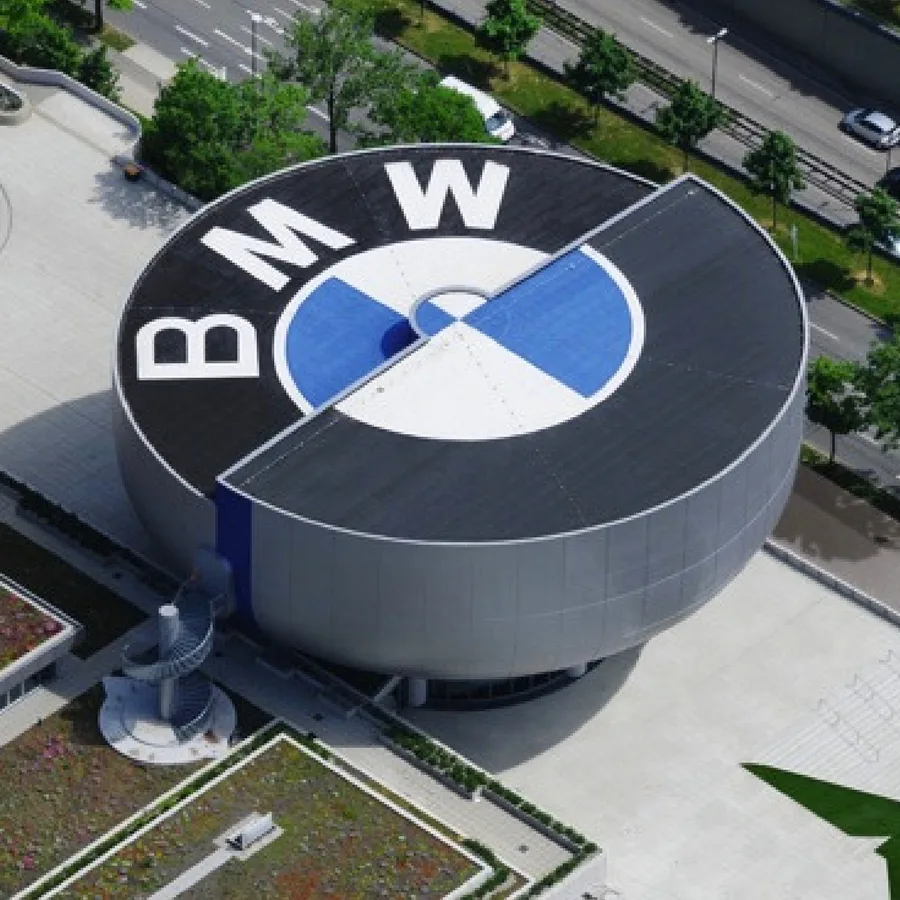
Day 3
Munich to Zurich
View More
Day 3
Munich to Zurich





Morning
Visit to the BMW Museum and the 1972 Olympic Park
If you have a passion for cars and German engineering precision, then you'll love the shrines to one of Germany's finest automobiles - the ultra-modern BMW Museum and the futuristic-looking BMW World. Adjacent to BMW World are the extensive and beautifully sculpted grounds of 1972's Olympic Park built on top of the mountain of rubble transported there during the post-WWII city clean-up operation.

Day 3
Munich to Zurich
View More


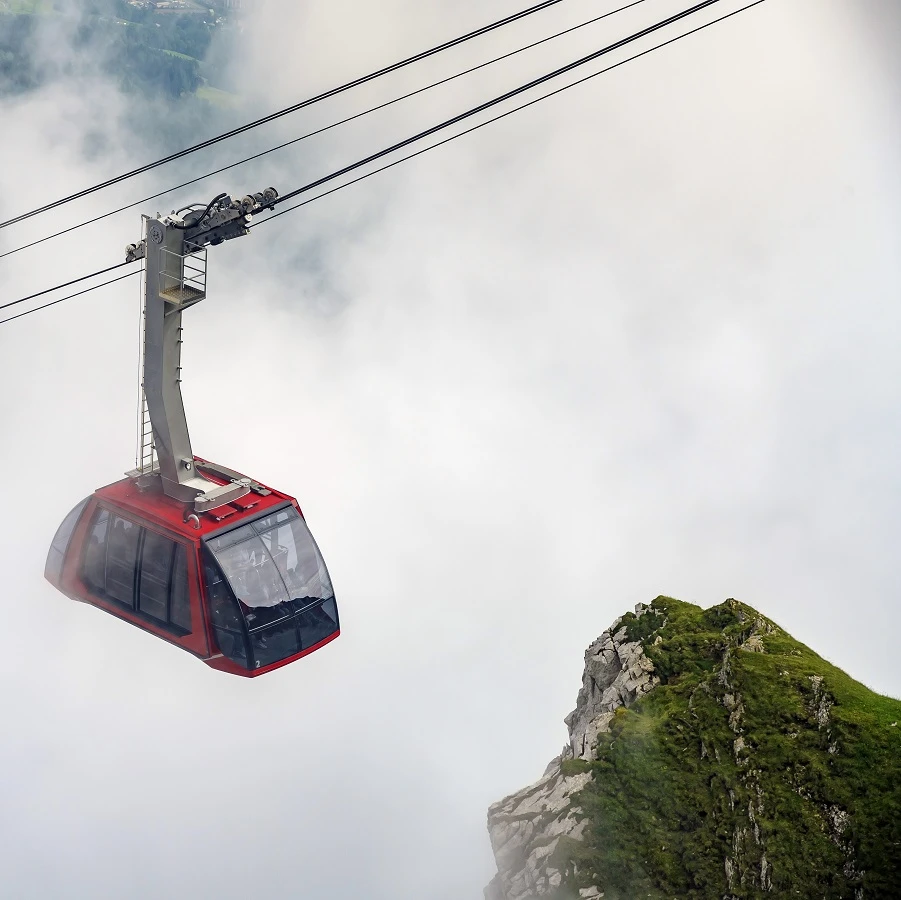
Day 4
Zurich
View More
Day 4
Zurich


Early Morning to Mid-Day
Self-Guided Excursion Up Mt Pilatus
In summer months, you can ride the steepest rack-railway in the world at a gradient of nearly 48 percent from Alpnachstad up the giant mountain of Mt Pilatus that looms over the city of Lucerne. In winter you can glide up the other side of the mountain on a cable car from Kriens. The highest point, Tomlishorn, with superlative views of Lake Lucerne, is only 30min on foot from the hotels and restaurants near the top.

Kriens-Pilatus Cable Car Station
Show More
Show More


Kriens-Pilatus Cable Car Station
Show More
Show More


Kriens-Pilatus Cable Car Station
Show More
Show More


Kriens-Pilatus Cable Car Station
Show More
Show More


Kriens-Pilatus Cable Car Station
Show More
Show More

prev
next

Day 4
Zurich
View More


Kriens-Pilatus Cable Car Station
 Highlight of Mt Pilatus
Highlight of Mt Pilatus

Kriens-Pilatus Cable Car Station
 Highlight of Mt Pilatus
Highlight of Mt Pilatus

Kriens-Pilatus Cable Car Station
 Highlight of Mt Pilatus
Highlight of Mt Pilatus

Kriens-Pilatus Cable Car Station
 Highlight of Mt Pilatus
Highlight of Mt Pilatus

Kriens-Pilatus Cable Car Station
 Highlight of Mt Pilatus
Highlight of Mt Pilatus
prev
next


Day 5
Zurich to Interlaken
View More
Day 5
Zurich to Interlaken





9:00 AM - 11:30 AM
Private Introductory tour of the Zurich Old Town
During this 2.5-hour private walking tour, you will learn how Switzerland became Switzerland, and why Zurich is its most populated and important city. The walk towards the lake will take you to the Lindenhof, where you will enjoy a marvelous view of the Limmat all the way over to the Grossmünster. From there you will head to the Fraumünster, passing by St. Peter's Church, which bears the biggest clock face in Europe. Passing by the side of the city's Grossmünster, you will walk from the Lake to the Niederdorfstrasse, where you will experience the focal point of Zurich's restaurants and bars.

Day 5
Zurich to Interlaken
View More


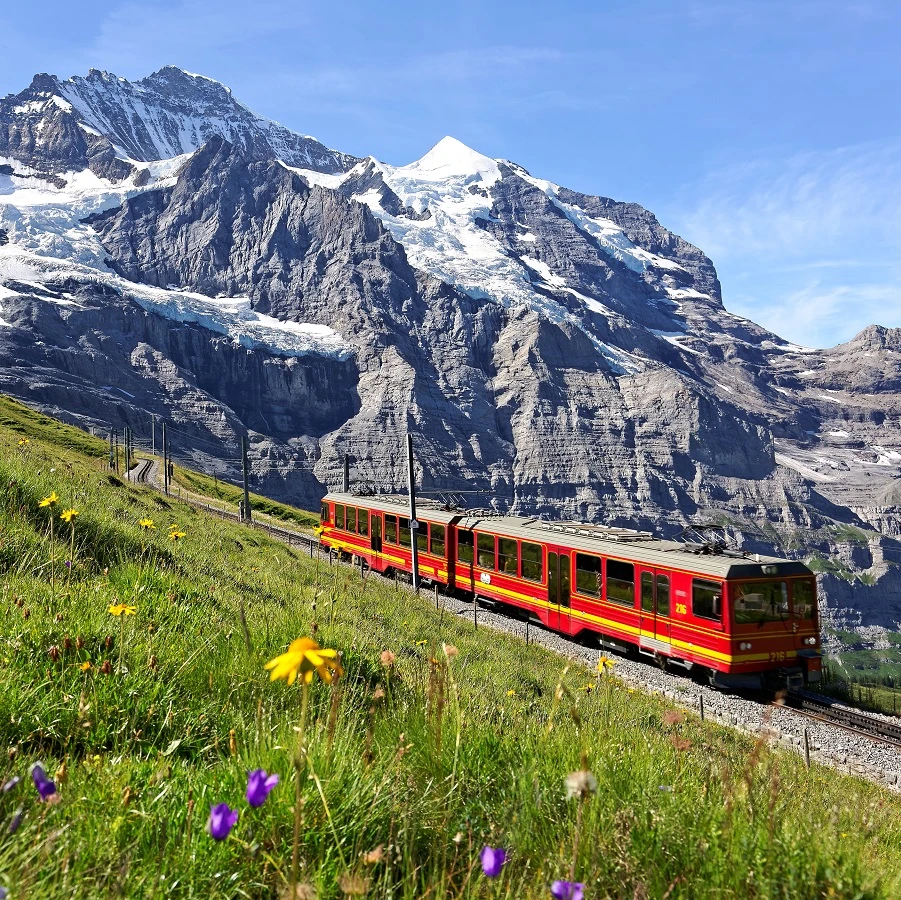
Day 6
Interlaken
View More
Day 6
Interlaken


Early Morning to Late Afternoon
Self-Guided Excursion up Jungfrau
Journey directly through the famous Eiger Mountain to what the Swiss called "The Top of Europe", the icy, windswept gap in the mountain ridges known as Jungfraujoch at 3,454m/11,332ft just below the summit of Jungfrau. The train ride to the top is not cheap, but it's the highest train station in Europe and definitely an unforgettable experience.

Grindelwald
Village in the Bernese Alps
Show More

Grindelwald
Village in the Bernese Alps
Show More

Grindelwald
Village in the Bernese Alps
Show More

Grindelwald
Village in the Bernese Alps
Show More

Grindelwald
Village in the Bernese Alps
Show More
prev
next

Day 6
Interlaken
View More

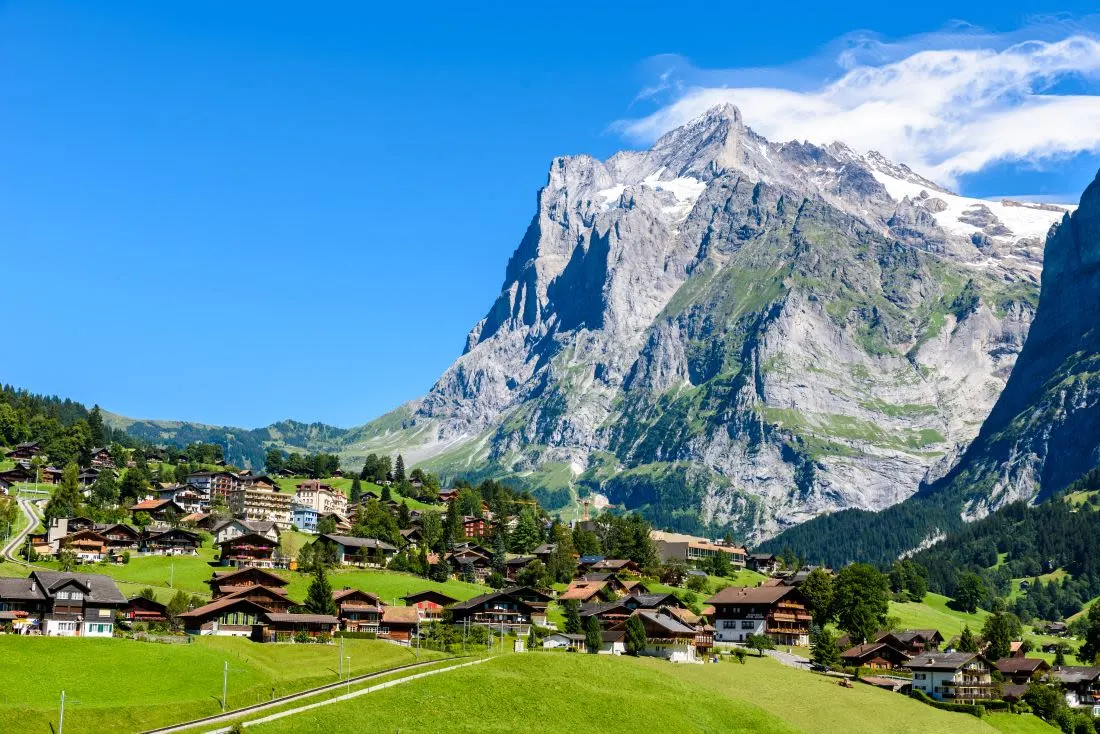
Grindelwald
 Highlight of Jungfrau
Highlight of JungfrauVillage in the Bernese Alps
Village in the Bernese Alps that is considered to be the gateway to the Jungfrau Region. This village is popular among hikers and alpinists

Grindelwald
 Highlight of Jungfrau
Highlight of JungfrauVillage in the Bernese Alps
Village in the Bernese Alps that is considered to be the gateway to the Jungfrau Region. This village is popular among hikers and alpinists

Grindelwald
 Highlight of Jungfrau
Highlight of JungfrauVillage in the Bernese Alps
Village in the Bernese Alps that is considered to be the gateway to the Jungfrau Region. This village is popular among hikers and alpinists

Grindelwald
 Highlight of Jungfrau
Highlight of JungfrauVillage in the Bernese Alps
Village in the Bernese Alps that is considered to be the gateway to the Jungfrau Region. This village is popular among hikers and alpinists

Grindelwald
 Highlight of Jungfrau
Highlight of JungfrauVillage in the Bernese Alps
Village in the Bernese Alps that is considered to be the gateway to the Jungfrau Region. This village is popular among hikers and alpinists
prev
next

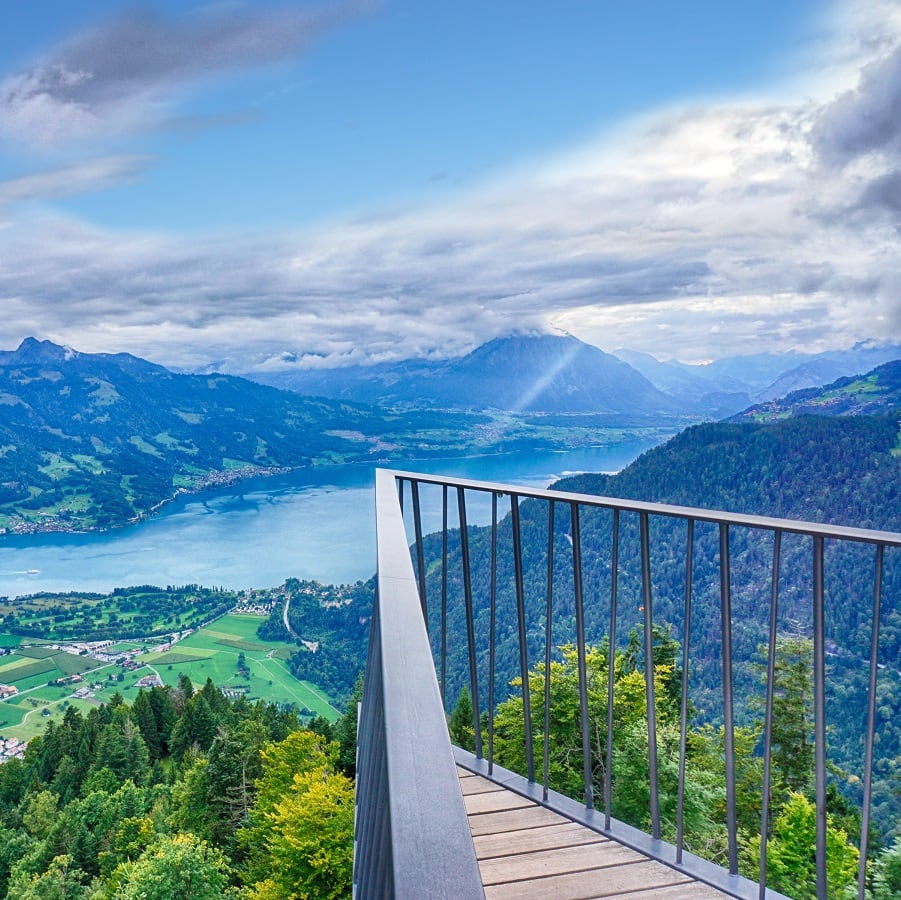
Day 7
Interlaken to Geneva
View More
Day 7
Interlaken to Geneva




Morning/Mid-Day
Self-Guided Excursion Up Harder Kulm
Travel by funicular from close to the Old Town in Interlaken to the Harder Kulm viewing platform at 1,322 meters above sea level from where you're able to soak up majestic panoramas of Lake Brienz and Lake Thun, or admire the Eiger, Mönch, and Jungfrau mountains. The castle-like the Harder Kulm Panorama Restaurant sometimes hosts folk music and dancing. The hike down, should you choose to go that way, will take around one hour.

Day 7
Interlaken to Geneva
View More


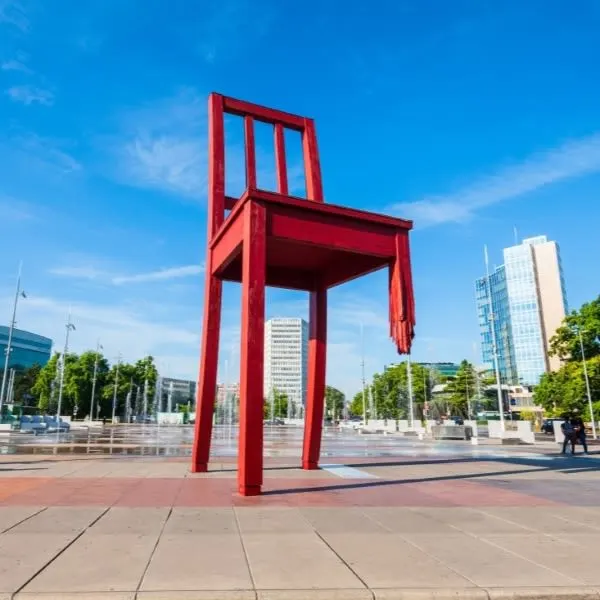
Day 8
Geneva
View More
Day 8
Geneva




9:00 AM - 11:00 AM
Privately Guided Walking Tour of Geneva
Your private guide will pick you up from your hotel and take you for a 2-hour walk through the center of Geneva. On this walk, you will visit Bastions Park where you’ll see the Reformation Wall, built in 1909 to celebrate religious reform in Europe. You'll discover special places related to people like Jean Calvin and Jean-Jacques Rousseau, or even presidents of the United States like Woodrow Wilson or Bill Clinton. You will also visit the peaceful Old Town with its majestic St. Peter’s Cathedral, the Jardin d’Anglais, to admire one of Patek Philippe’s most famous works, and the surprising, delightful Flower Clock. The tour will end at the Nations Park, where you will see the United Nations Organization Headquarters.

Reformation Wall
A monumental reminder of Geneva’s history and influence during the Reformation.
Show More

Reformation Wall
A monumental reminder of Geneva’s history and influence during the Reformation.
Show More

Reformation Wall
A monumental reminder of Geneva’s history and influence during the Reformation.
Show More

Reformation Wall
A monumental reminder of Geneva’s history and influence during the Reformation.
Show More

Reformation Wall
A monumental reminder of Geneva’s history and influence during the Reformation.
Show More
prev
next

Day 8
Geneva
View More

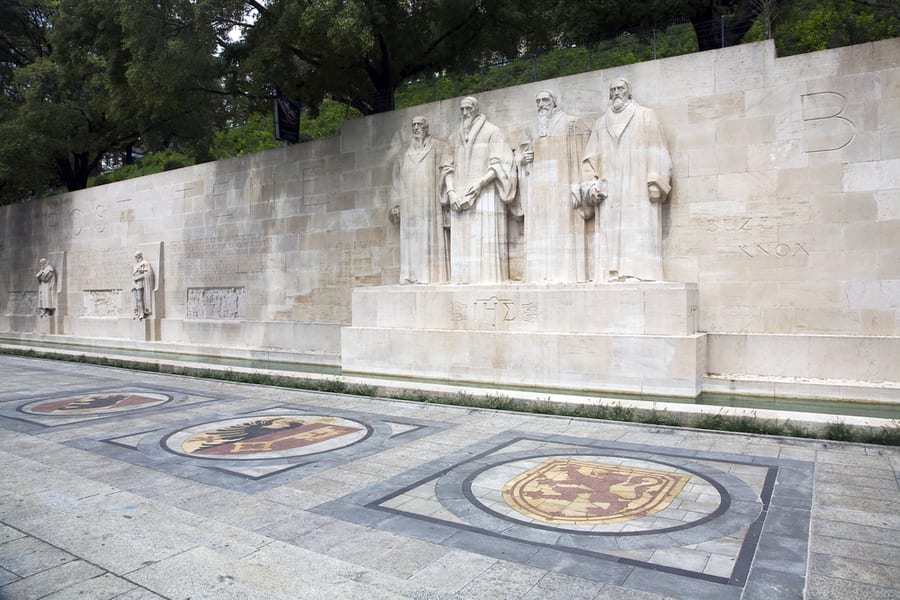
Reformation Wall
 Highlight of Highlights Walking Tour
Highlight of Highlights Walking TourA monumental reminder of Geneva’s history and influence during the Reformation.
The men depicted on the wall are the main protagonists of the Reformation, John Calvin, Willian Farel, Theodore Beza, and John Knox. Engraved on the wall is the Genevan motto “Post Tenebras Lux” which translates to “light after darkness.”

Reformation Wall
 Highlight of Highlights Walking Tour
Highlight of Highlights Walking TourA monumental reminder of Geneva’s history and influence during the Reformation.
The men depicted on the wall are the main protagonists of the Reformation, John Calvin, Willian Farel, Theodore Beza, and John Knox. Engraved on the wall is the Genevan motto “Post Tenebras Lux” which translates to “light after darkness.”

Reformation Wall
 Highlight of Highlights Walking Tour
Highlight of Highlights Walking TourA monumental reminder of Geneva’s history and influence during the Reformation.
The men depicted on the wall are the main protagonists of the Reformation, John Calvin, Willian Farel, Theodore Beza, and John Knox. Engraved on the wall is the Genevan motto “Post Tenebras Lux” which translates to “light after darkness.”

Reformation Wall
 Highlight of Highlights Walking Tour
Highlight of Highlights Walking TourA monumental reminder of Geneva’s history and influence during the Reformation.
The men depicted on the wall are the main protagonists of the Reformation, John Calvin, Willian Farel, Theodore Beza, and John Knox. Engraved on the wall is the Genevan motto “Post Tenebras Lux” which translates to “light after darkness.”

Reformation Wall
 Highlight of Highlights Walking Tour
Highlight of Highlights Walking TourA monumental reminder of Geneva’s history and influence during the Reformation.
The men depicted on the wall are the main protagonists of the Reformation, John Calvin, Willian Farel, Theodore Beza, and John Knox. Engraved on the wall is the Genevan motto “Post Tenebras Lux” which translates to “light after darkness.”
prev
next


Day 9
Geneva to Paris
View More
Day 9
Geneva to Paris




Early Morning to Mid-Day
Self Guided Excursion to Montreux
The traditional Swiss city of Montreux lies nestled among the mountains along the shore of Lake Geneva. Montreux is known for its microclimate, and the Montreux jazz festival held every year in July. Spend the day strolling along the promenade admiring not only the typical Swiss views of Lake Geneva and the Alps, but also the Mediterranean tree and Belle Époque buildings. Not far from the city is the famous Château de Chillon, a medieval castle on an island that is complete with ramparts, halls, and chapel.

Lake Geneva
Lake
Show More

Chillon Castle
Lakeside castle that is a popular attraction near Montreux
Show More

Lake Geneva
Lake
Show More

Chillon Castle
Lakeside castle that is a popular attraction near Montreux
Show More

Lake Geneva
Lake
Show More

Chillon Castle
Lakeside castle that is a popular attraction near Montreux
Show More
prev
next

Day 9
Geneva to Paris
View More

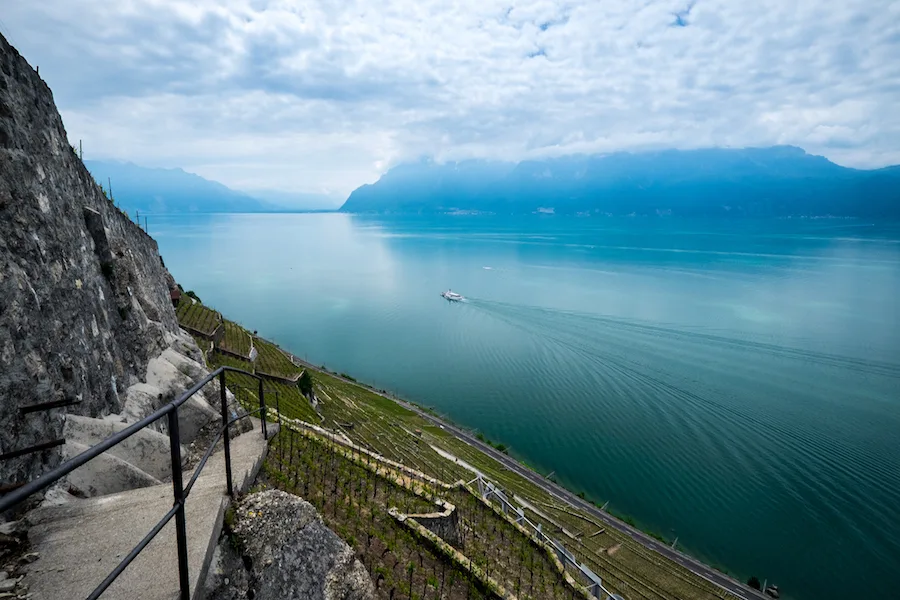
Lake Geneva
 Highlight of Excursion to Montreux
Highlight of Excursion to Montreux Lake
Lake Geneva (Lac Léman) is a crescent-shaped lake shared between France and Switzerland and overlooked by the Alps.
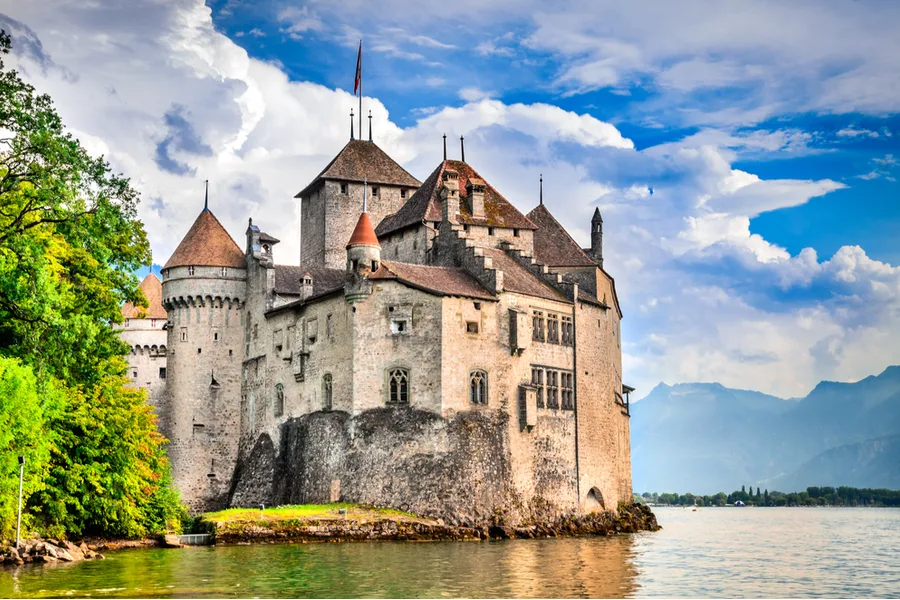
Chillon Castle
 Highlight of Excursion to Montreux
Highlight of Excursion to Montreux Lakeside castle that is a popular attraction near Montreux
Chillon Castle is an island castle located on Lake Geneva, south of Veytaux. It is one of the most visited castles in Switzerland. During the 16th century Wars of Religion, it was used by the dukes of Savoy to house prisoners

Lake Geneva
 Highlight of Excursion to Montreux
Highlight of Excursion to Montreux Lake
Lake Geneva (Lac Léman) is a crescent-shaped lake shared between France and Switzerland and overlooked by the Alps.

Chillon Castle
 Highlight of Excursion to Montreux
Highlight of Excursion to Montreux Lakeside castle that is a popular attraction near Montreux
Chillon Castle is an island castle located on Lake Geneva, south of Veytaux. It is one of the most visited castles in Switzerland. During the 16th century Wars of Religion, it was used by the dukes of Savoy to house prisoners

Lake Geneva
 Highlight of Excursion to Montreux
Highlight of Excursion to Montreux Lake
Lake Geneva (Lac Léman) is a crescent-shaped lake shared between France and Switzerland and overlooked by the Alps.

Chillon Castle
 Highlight of Excursion to Montreux
Highlight of Excursion to Montreux Lakeside castle that is a popular attraction near Montreux
Chillon Castle is an island castle located on Lake Geneva, south of Veytaux. It is one of the most visited castles in Switzerland. During the 16th century Wars of Religion, it was used by the dukes of Savoy to house prisoners
prev
next


Day 10
Paris
View More
Day 10
Paris




9:00 AM - 1:00 PM
Private Guided Walking Tour of the Center of Paris
Embark on a captivating 4-hour walking tour of the center of Paris, the City of Lights, where history and modernity blend seamlessly along its enchanting streets. Starting from your accommodation, you will explore the heart of this dynamic city and learn how to navigate Paris as a local.

Day 10
Paris
View More



Day 11
Paris
View More
Day 11
Paris



Early Morning/Morning
All You Need is Louvre - A Visit to the World's Largest Art Museum
It might be the greatest art museum in the world; it certainly is the largest with over 380,000 objects; to view every single one for even a minute apiece would take 75 days. And those descriptions still don't do the building and its collection justice. Marvel at treasures inside, including Leonardo Da Vinci's mysterious woman, the Mona Lisa, and everything from an Egyptian masterpiece of mummification to the famed Hellenistic sculpture, Venus de Milo, to patriotic French masterpieces like Delacroix’s Liberty Leading the People. Although the Louvre is vast and ever-crowded, with some strategy and a few helpful tips your visit will take in maximum artworks with minimal hassle.

Day 11
Paris
View More


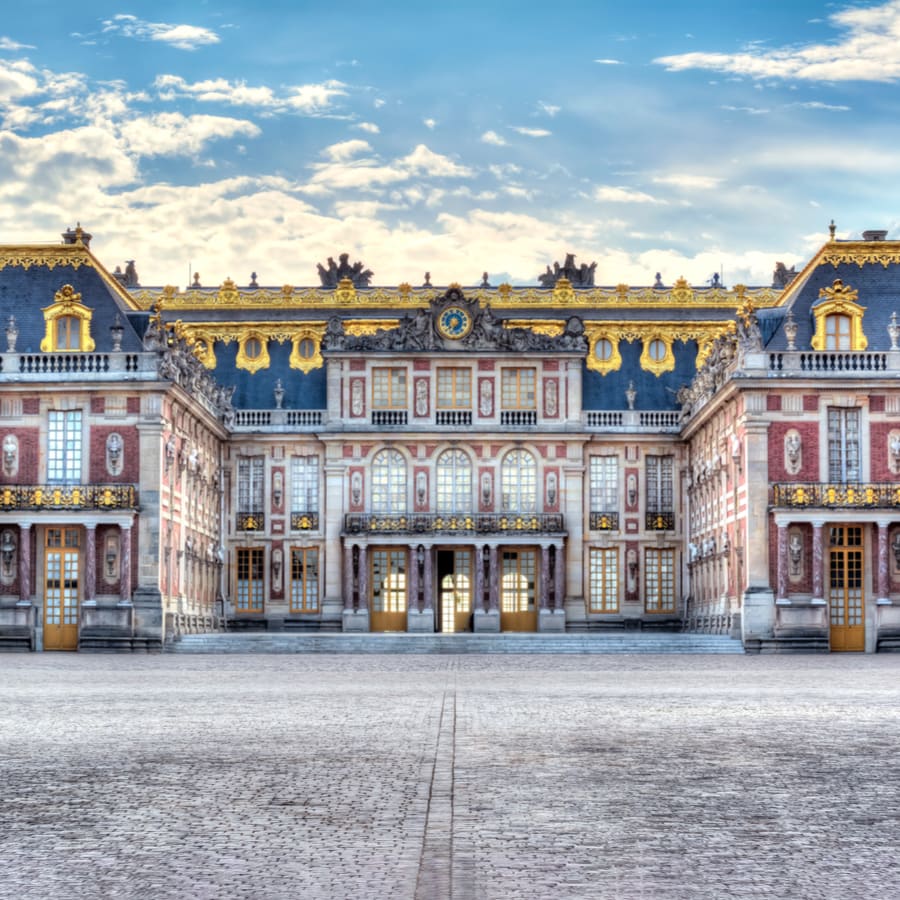
Day 12
Paris
View More
Day 12
Paris


Early Morning to Mid-Day
Grand & Grand Gardeners, Visiting the Palace of Versailles
The Château of Versailles, a symbol of the grandeur of French monarchy, invites visitors to explore its lavish history and architectural majesty. From the spellbinding elegance of the Hall of Mirrors, where the Treaty of Versailles was signed, to the vast, meticulously manicured Gardens the pinnacle of French garden design, every corner tells a story of opulence and power. Discover the intimate escapes of royalty at the Grand and Petit Trianon, and marvel at the divine beauty of the Royal Chapel, a masterpiece of Baroque architecture.

The Queen's Hamlet
Imagine living like the "peasants" here?
Show More

Parc de Versailles
Feel like a king, feel like a queen, hopefully you'll feel good looking out across the park
Show More

Main Palace of Versailles
There are palaces, and then there is Versailles...
Show More

The Queen's Hamlet
Imagine living like the "peasants" here?
Show More

Parc de Versailles
Feel like a king, feel like a queen, hopefully you'll feel good looking out across the park
Show More

Main Palace of Versailles
There are palaces, and then there is Versailles...
Show More

The Queen's Hamlet
Imagine living like the "peasants" here?
Show More
prev
next

Day 12
Paris
View More

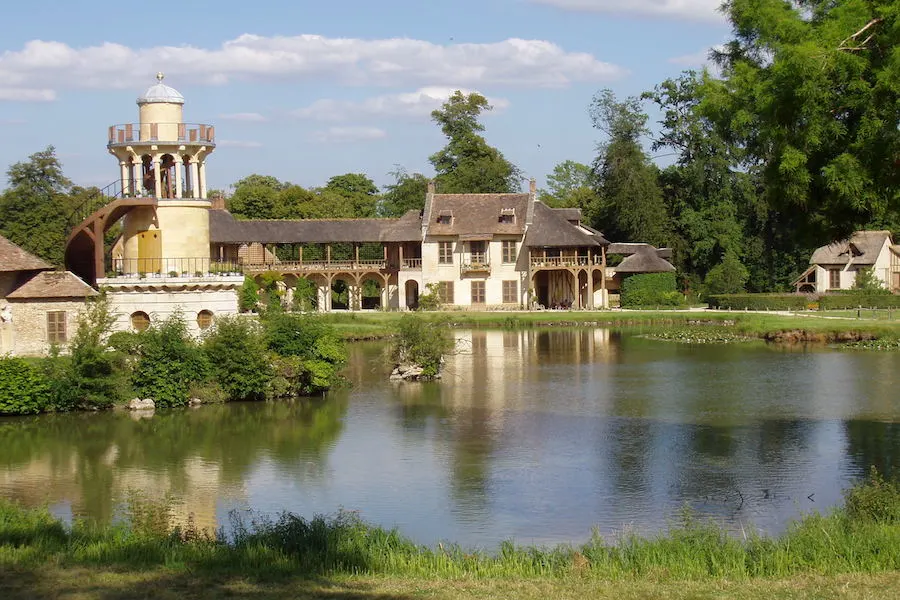
The Queen's Hamlet
 Highlight of Palace of Versailles
Highlight of Palace of VersaillesImagine living like the "peasants" here?
Desiring something different, Queen Marie Antoinette had a hamlet erected where she could supervise servants milking cows, tending pigs, collecting eggs from chickens. She dressed down to play her part, but apparently never got her hands dirty, as far as we know. Her peasant cottage only had two living rooms, a billiard room, a dining hall, and a library. If you are accustomed to palaces, only two living rooms is roughing it. Lest the queen got tired of it all, she could return to the Petit Trianon, a beautiful chateau built on the grounds of the Grand Trianon, which was the retreat chateau built on the grounds of the Palace of Versailles, which was a retreat from the Louvre Palace in Paris.
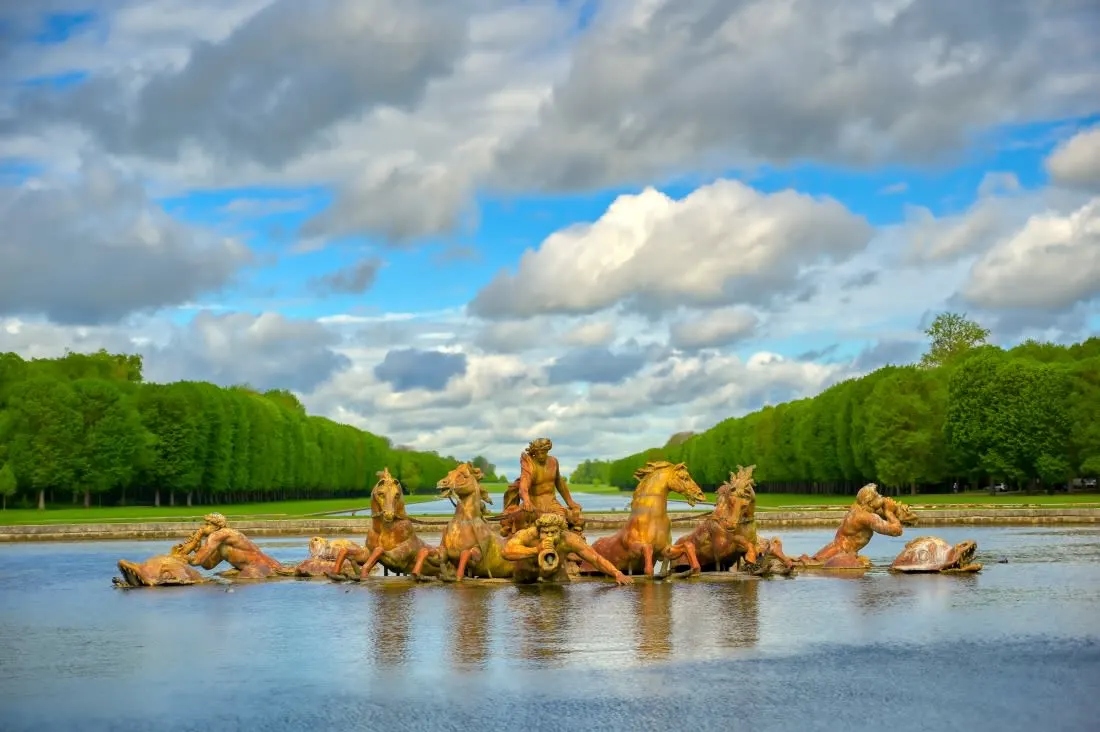
Parc de Versailles
 Highlight of Palace of Versailles
Highlight of Palace of VersaillesFeel like a king, feel like a queen, hopefully you'll feel good looking out across the park
The Parc de Versailles, features some 800 hectares of manicured lawns, stunning fountains, and the Grand Canal, all masterminded by André Le Nôtre. Highlights include the Neptune and Apollo Fountains, the Trianon Palaces, and the Queen's Hamlet. This vast garden symbolizes royal power, but you are welcomed to enjoy yourself on these pleasure grounds.
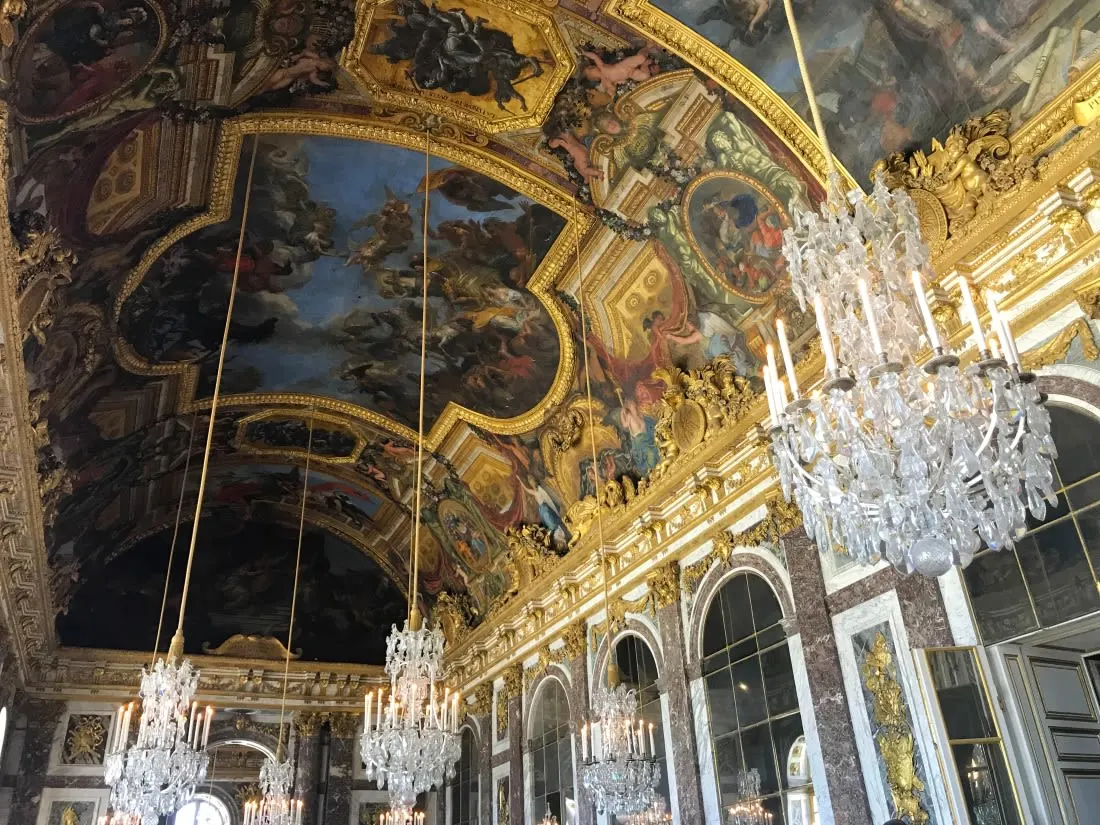
Main Palace of Versailles
 Highlight of Palace of Versailles
Highlight of Palace of VersaillesThere are palaces, and then there is Versailles...
Enlarged by for Emperor Louis XIV as an escape from the dreary political tension of Paris, Versailles might have been the most luxurious palace in the world. Even now, the building stuptifies with its grandeur and elegance, a stunning representation of the French monarchy's opulence. The famous Hall of Mirrors is just one of many, many (2300!) stunning rooms, only a small percentage of which are open for display. It might be too much, or one visit might never be enough.

The Queen's Hamlet
 Highlight of Palace of Versailles
Highlight of Palace of VersaillesImagine living like the "peasants" here?
Desiring something different, Queen Marie Antoinette had a hamlet erected where she could supervise servants milking cows, tending pigs, collecting eggs from chickens. She dressed down to play her part, but apparently never got her hands dirty, as far as we know. Her peasant cottage only had two living rooms, a billiard room, a dining hall, and a library. If you are accustomed to palaces, only two living rooms is roughing it. Lest the queen got tired of it all, she could return to the Petit Trianon, a beautiful chateau built on the grounds of the Grand Trianon, which was the retreat chateau built on the grounds of the Palace of Versailles, which was a retreat from the Louvre Palace in Paris.

Parc de Versailles
 Highlight of Palace of Versailles
Highlight of Palace of VersaillesFeel like a king, feel like a queen, hopefully you'll feel good looking out across the park
The Parc de Versailles, features some 800 hectares of manicured lawns, stunning fountains, and the Grand Canal, all masterminded by André Le Nôtre. Highlights include the Neptune and Apollo Fountains, the Trianon Palaces, and the Queen's Hamlet. This vast garden symbolizes royal power, but you are welcomed to enjoy yourself on these pleasure grounds.

Main Palace of Versailles
 Highlight of Palace of Versailles
Highlight of Palace of VersaillesThere are palaces, and then there is Versailles...
Enlarged by for Emperor Louis XIV as an escape from the dreary political tension of Paris, Versailles might have been the most luxurious palace in the world. Even now, the building stuptifies with its grandeur and elegance, a stunning representation of the French monarchy's opulence. The famous Hall of Mirrors is just one of many, many (2300!) stunning rooms, only a small percentage of which are open for display. It might be too much, or one visit might never be enough.

The Queen's Hamlet
 Highlight of Palace of Versailles
Highlight of Palace of VersaillesImagine living like the "peasants" here?
Desiring something different, Queen Marie Antoinette had a hamlet erected where she could supervise servants milking cows, tending pigs, collecting eggs from chickens. She dressed down to play her part, but apparently never got her hands dirty, as far as we know. Her peasant cottage only had two living rooms, a billiard room, a dining hall, and a library. If you are accustomed to palaces, only two living rooms is roughing it. Lest the queen got tired of it all, she could return to the Petit Trianon, a beautiful chateau built on the grounds of the Grand Trianon, which was the retreat chateau built on the grounds of the Palace of Versailles, which was a retreat from the Louvre Palace in Paris.
prev
next

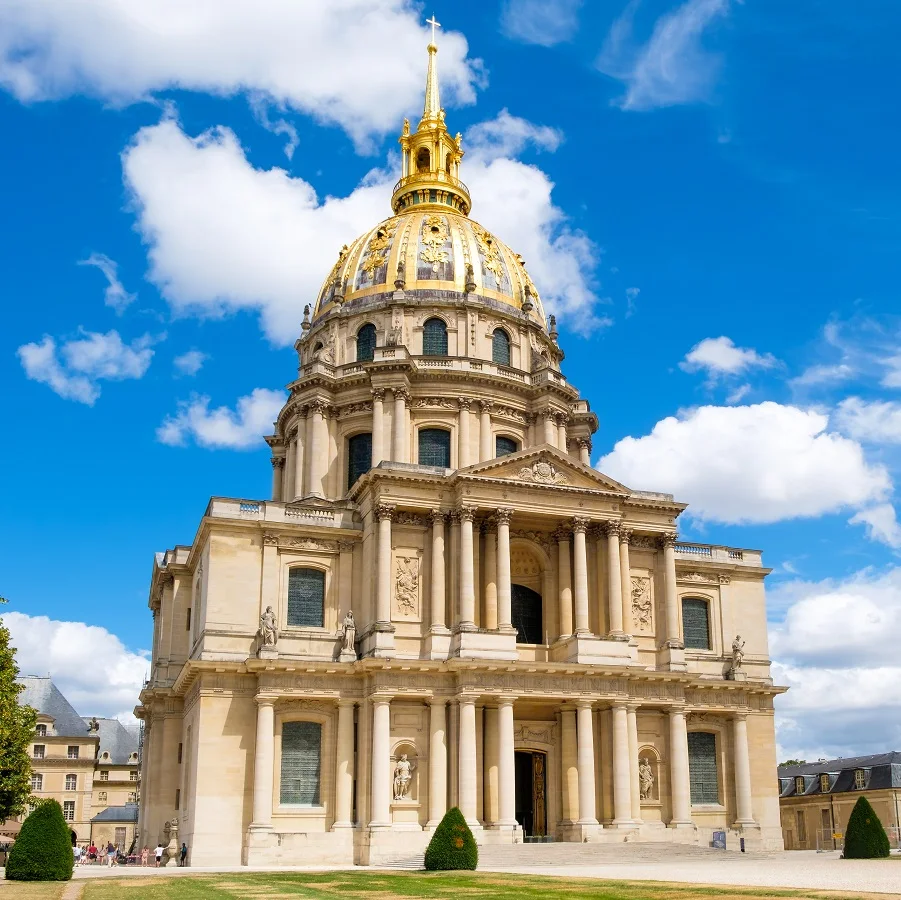
Day 13
Paris
View More
Day 13
Paris



Morning
Invade the Hôtel des Invalides
The Eglise du Dome Church close to the Eiffel Tower is where you observe the gilded tomb of the historic French General and Emperor, Napoleon, but his bones are just a miniscule part of the gigantic Hôtel des Invalides housing the French National Army Museum. Spend some time learning about French warfare from the earliest times to the wax and wane of the Napoloenic Wars and on to the modern French army and a new section dedicated to the life of General Charles de Gaulle.

The Army Museum
Exploring the martial history of France in this regal strucure
Show More

Rodin Museum
Let the greatest sculptures of the 19th and 20th centuries inspire you
Show More

Napoleon's Tomb
Discover the tomb of one of history's most fearsome generals, and a controversial figure of the 19th century.
Show More

The Army Museum
Exploring the martial history of France in this regal strucure
Show More

Rodin Museum
Let the greatest sculptures of the 19th and 20th centuries inspire you
Show More

Napoleon's Tomb
Discover the tomb of one of history's most fearsome generals, and a controversial figure of the 19th century.
Show More

The Army Museum
Exploring the martial history of France in this regal strucure
Show More
prev
next

Day 13
Paris
View More

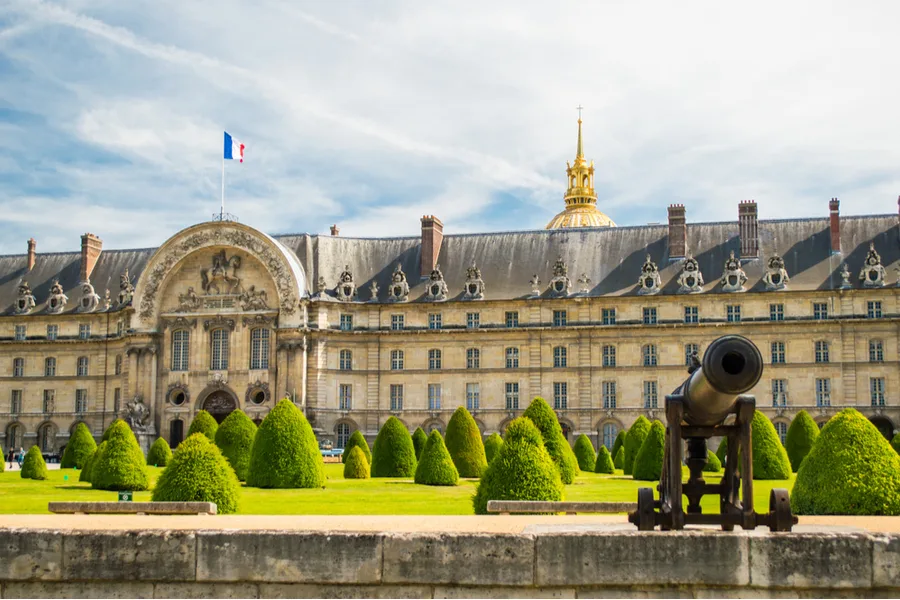
The Army Museum
 Highlight of Hôtel des Invalides
Highlight of Hôtel des InvalidesExploring the martial history of France in this regal strucure
Gather your forces and lay touristic seige to the French Army Museum and its immersive expositions of French military history from medieval times to the present. Will you conquer the extensive Medieval Collections, Napoleon Bonaparte's grand tomb, and detailed exhibits of the World Wars, or will they conquer you? These exhibts and more offer insights into the evolution of warfare, strategic intracacies, and personal narratives of conflict. A visit to the Army Museum encourages discussion about the contradictions and complexities of war, one of the most important, and disturbing, traits of our humanity.
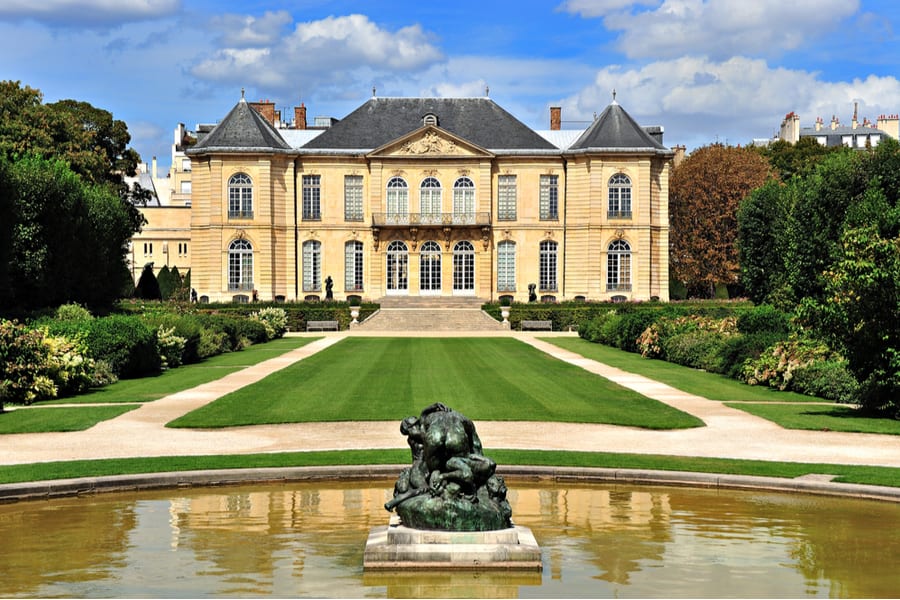
Rodin Museum
 Highlight of Hôtel des Invalides
Highlight of Hôtel des InvalidesLet the greatest sculptures of the 19th and 20th centuries inspire you
The remarkable sanctuary of art and beauty that is the Musée de Rodin displays the greatest works of the French sculptor Auguste Rodin. Nestled in the exquisite Hôtel Biron, and its serene garden, this museum invites visitors to discover the profound depth of Rodin's creativity. Thrill at the world-reknowned pieces "The Thinker" and "The Gates of Hell," among others, each piece exploring human emotion and thought through its dynamic forms. Wander through the garden paths to encounter these and other masterpieces in an intimate setting, where the fusion of art and nature crafts a truly unforgettable experience.
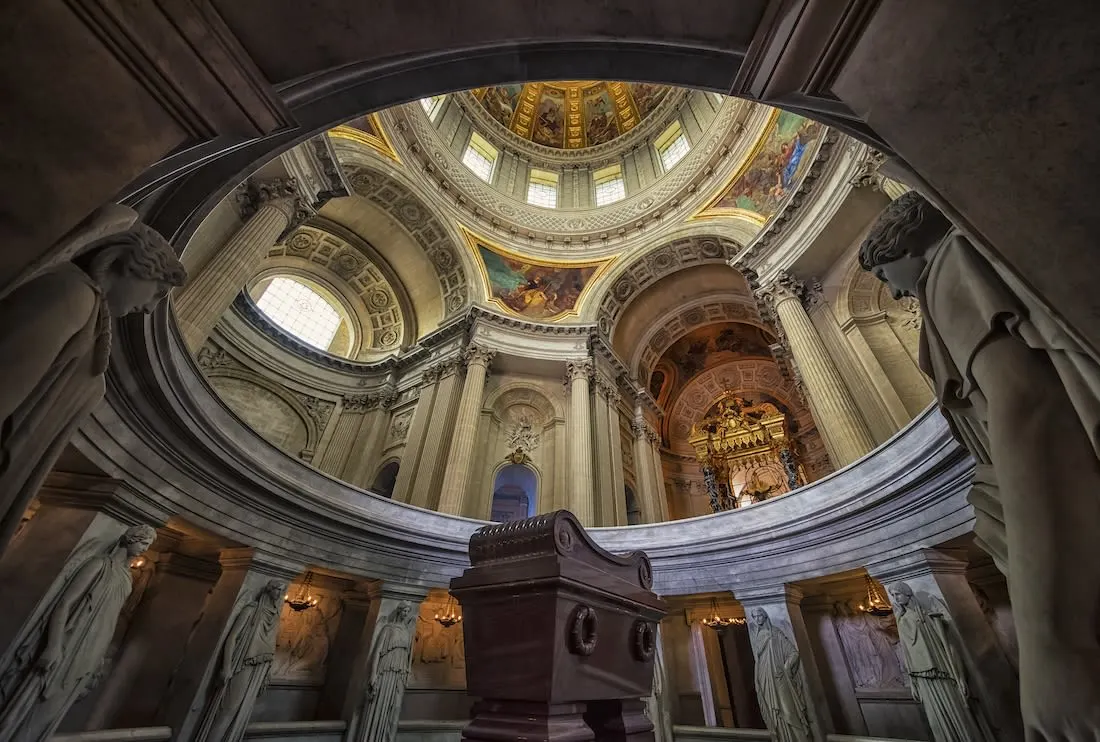
Napoleon's Tomb
 Highlight of Hôtel des Invalides
Highlight of Hôtel des InvalidesDiscover the tomb of one of history's most fearsome generals, and a controversial figure of the 19th century.
Reflect at the sarcophagus resting underneath the dome of Les Invalides' church - Napoleon's tomb is as still as his life was frenetic. Crafted from red quartzite and set upon a green granite base within a circular crypt, Napoleon's sarcophagus is surrounded by a series of statues representing his victories and achievements. The entire ensemble, designed with solemn grandeur, reflect both the power and complexity of his legacy. But visitors can come and go please, this great general commands no one now.

The Army Museum
 Highlight of Hôtel des Invalides
Highlight of Hôtel des InvalidesExploring the martial history of France in this regal strucure
Gather your forces and lay touristic seige to the French Army Museum and its immersive expositions of French military history from medieval times to the present. Will you conquer the extensive Medieval Collections, Napoleon Bonaparte's grand tomb, and detailed exhibits of the World Wars, or will they conquer you? These exhibts and more offer insights into the evolution of warfare, strategic intracacies, and personal narratives of conflict. A visit to the Army Museum encourages discussion about the contradictions and complexities of war, one of the most important, and disturbing, traits of our humanity.

Rodin Museum
 Highlight of Hôtel des Invalides
Highlight of Hôtel des InvalidesLet the greatest sculptures of the 19th and 20th centuries inspire you
The remarkable sanctuary of art and beauty that is the Musée de Rodin displays the greatest works of the French sculptor Auguste Rodin. Nestled in the exquisite Hôtel Biron, and its serene garden, this museum invites visitors to discover the profound depth of Rodin's creativity. Thrill at the world-reknowned pieces "The Thinker" and "The Gates of Hell," among others, each piece exploring human emotion and thought through its dynamic forms. Wander through the garden paths to encounter these and other masterpieces in an intimate setting, where the fusion of art and nature crafts a truly unforgettable experience.

Napoleon's Tomb
 Highlight of Hôtel des Invalides
Highlight of Hôtel des InvalidesDiscover the tomb of one of history's most fearsome generals, and a controversial figure of the 19th century.
Reflect at the sarcophagus resting underneath the dome of Les Invalides' church - Napoleon's tomb is as still as his life was frenetic. Crafted from red quartzite and set upon a green granite base within a circular crypt, Napoleon's sarcophagus is surrounded by a series of statues representing his victories and achievements. The entire ensemble, designed with solemn grandeur, reflect both the power and complexity of his legacy. But visitors can come and go please, this great general commands no one now.

The Army Museum
 Highlight of Hôtel des Invalides
Highlight of Hôtel des InvalidesExploring the martial history of France in this regal strucure
Gather your forces and lay touristic seige to the French Army Museum and its immersive expositions of French military history from medieval times to the present. Will you conquer the extensive Medieval Collections, Napoleon Bonaparte's grand tomb, and detailed exhibits of the World Wars, or will they conquer you? These exhibts and more offer insights into the evolution of warfare, strategic intracacies, and personal narratives of conflict. A visit to the Army Museum encourages discussion about the contradictions and complexities of war, one of the most important, and disturbing, traits of our humanity.
prev
next

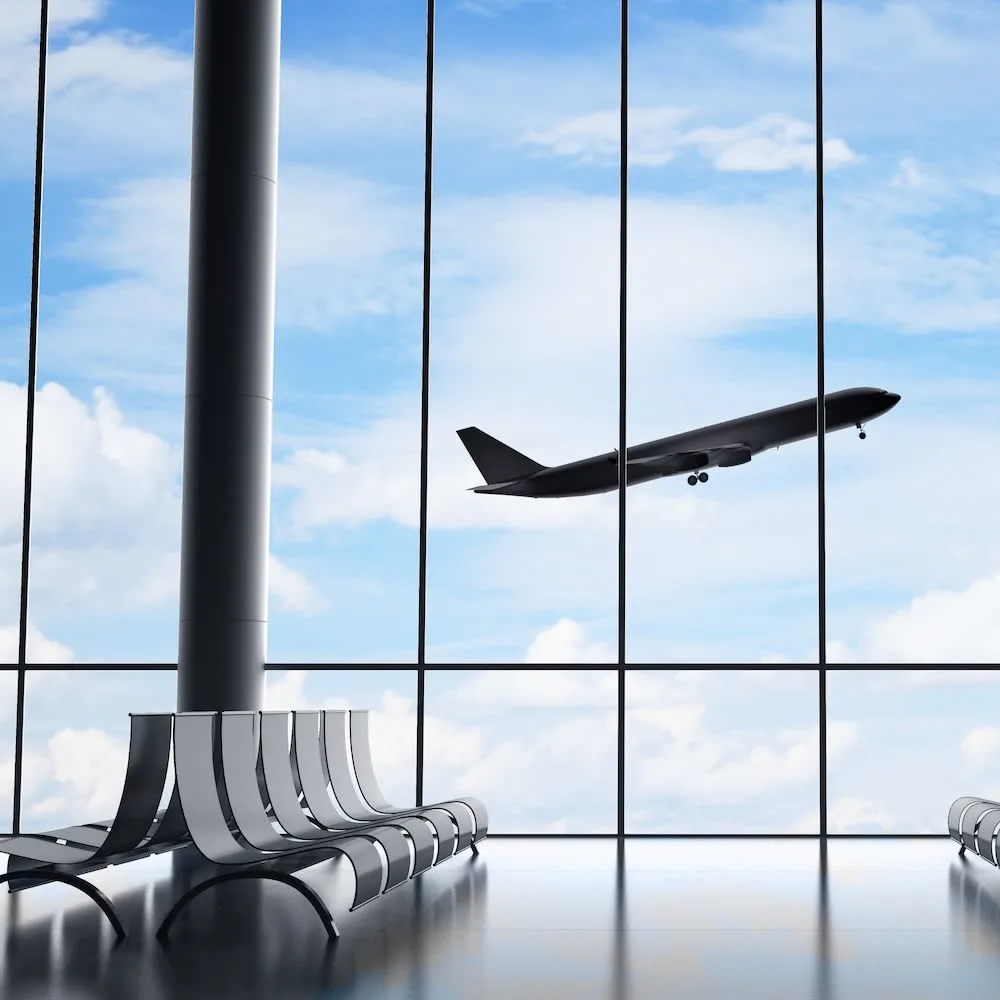
Day 14
Depart Paris
View More
Day 14
Depart Paris

To Be Determined
Airport Dropoff by Taxi
Paris taxis are generally reliable and honest, so taking a taxi is cheaper than a pre-arranged transfer. Your hotel will be happy to arrange a pick up for you. If you are picked up about 3.5 hours before your departure time, you should arrive at the airport with a little over two hours to spare. If you are leaving during rush hour, you may want to budget an extra fifteen minutes or so. There are also alternative transport instructions for buses and trains in the Full Itinerary if wish you save on the taxi fare. line-holder NOTE : If you're leaving from Beauvais Airport you should definitely take a shuttle bus because it's 75km/46.6mi from the city center.

Day 14
Depart Paris
View More


What's Included In Your Trip

Pre-Paid Tours and Activities:
- Guided Walk Tour of Historic Munich
- Private Introductory tour of the Zurich Old Town
- Privately Guided Walking Tour of Geneva
- Private Guided Walking Tour of the Center of Paris
- Small Group Food Tour of Montmartre District
- City Card for Munich, including discounts to many popular attractions

Pre-Paid Transportation:
- 2nd Class Train Tickets from Munich-Zurich
- 2nd Class Train Tickets from Genève to Paris Gare de Lyon
- Public Transport Tickets for Munich
- Swiss Travel Pass

Accommodation:
- 3 nights at a hotel of your choice in Munich
- 3 nights at a hotel of your choice in Zurich
- 3 nights at a hotel of your choice in Interlaken
- 3 nights at a hotel of your choice in Geneva
- 6 nights at a hotel of your choice in Paris

Go Real Travel Mobile App:
- Itinerary Plan & Reservations Info
- Points of Interest
- Detailed Travel Information
- Maps & Directions
Other Trips You May Like

14 Days
From$4249USD
Swiss Adventure with Germany & Italy: Lakes, Castles & Cultural Wonders

Germany, Switzerland, Italy

21 Days
From$5199USD
Central European Journey through Switzerland, Germany, Austria and the Czech Republic

Switzerland, Germany, Austria, Czech Republic

7 Days
From$1899USD

10 Days
From$3095USD

10 Days
From$3675USD

10 Days
From$3599USD

14 Days
From$4250USD

14 Days
From$3885USD

14 Days
From$3775USD
Alpine Enchantment: A Family Adventure Through Historic Cities & Scenic Landscapes

Switzerland, Germany, Austria

14 Days
From$4249USD
Swiss Adventure with Germany & Italy: Lakes, Castles & Cultural Wonders

Germany, Switzerland, Italy

21 Days
From$5199USD
Central European Journey through Switzerland, Germany, Austria and the Czech Republic

Switzerland, Germany, Austria, Czech Republic

7 Days
From$1899USD

10 Days
From$3095USD

10 Days
From$3675USD

10 Days
From$3599USD

14 Days
From$4250USD

14 Days
From$3885USD

14 Days
From$3775USD
Alpine Enchantment: A Family Adventure Through Historic Cities & Scenic Landscapes

Switzerland, Germany, Austria
prev
next
Featured Blogs
prev
next
Our Customers Say It Best
Otto Chuy, Los Angeles, California
I am still surprised how everything worked as planned, without a hitch. All instructions in your itinerary were precise and correct. Your suggestions and comments in each of the locations we went to were very helpful. All your guides, without exception, were wonderful and exactly on time. 

Kathy Mongeau, Ottawa, Ontario
My sister, Ann Ibberson, and I have been back home for a few weeks now and still go on and on about our fabulous trip. We were just blown away in every respect. Given the fact that we only had 1 ½ weeks, you had everything arranged for us so efficiently and your contacts who we dealt with for transfers, tours, hotels were extremely professional and personable. Things could not have gone better. 

Clive Andrew, Brisbane, Queensland
Just a quick note to let you know that I am back home now after probably the best overseas holiday that I have ever had, in no small part due to your very capable organization booking of hotels, tours, & trains. There was just nothing that went wrong with the timings etc. 

Malini Dutta, Boston, Massachusetts
We can't thank you enough for the detailed plans, maps, and suggestions. It really felt that someone was holding our hands and showing us around. We had all the excitement of discovering foreign lands, with none of the problems that can happen while negotiating unfamiliar places. In fact, all the cities felt like home within a few hours of arriving and exploring. 

Bev and Mark Frankel, Williamsburg, Virginia
We could not be more pleased with Go Real Travel! You took the guess work out of things like public transport but still managed to allow us the freedom to tour as we wanted. Our guides were exceptional and every time I saw a Viking Cruise tour of 25 people, I realized the quality experience we were getting with Go Real. 

Marianne Strydom, Paarl, South Africa
I just wanted to thank you for organizing an amazing trip for me – I packed in so much in such a short period of time and everything was just perfect. The way you do things makes it possible to really get to know the destination, which for me as a travel agent could not have been better. 

Otto Chuy, Los Angeles, California
I am still surprised how everything worked as planned, without a hitch. All instructions in your itinerary were precise and correct. Your suggestions and comments in each of the locations we went to were very helpful. All your guides, without exception, were wonderful and exactly on time. 

Kathy Mongeau, Ottawa, Ontario
My sister, Ann Ibberson, and I have been back home for a few weeks now and still go on and on about our fabulous trip. We were just blown away in every respect. Given the fact that we only had 1 ½ weeks, you had everything arranged for us so efficiently and your contacts who we dealt with for transfers, tours, hotels were extremely professional and personable. Things could not have gone better. 

Clive Andrew, Brisbane, Queensland
Just a quick note to let you know that I am back home now after probably the best overseas holiday that I have ever had, in no small part due to your very capable organization booking of hotels, tours, & trains. There was just nothing that went wrong with the timings etc. 

Malini Dutta, Boston, Massachusetts
We can't thank you enough for the detailed plans, maps, and suggestions. It really felt that someone was holding our hands and showing us around. We had all the excitement of discovering foreign lands, with none of the problems that can happen while negotiating unfamiliar places. In fact, all the cities felt like home within a few hours of arriving and exploring. 

Bev and Mark Frankel, Williamsburg, Virginia
We could not be more pleased with Go Real Travel! You took the guess work out of things like public transport but still managed to allow us the freedom to tour as we wanted. Our guides were exceptional and every time I saw a Viking Cruise tour of 25 people, I realized the quality experience we were getting with Go Real. 

Marianne Strydom, Paarl, South Africa
I just wanted to thank you for organizing an amazing trip for me – I packed in so much in such a short period of time and everything was just perfect. The way you do things makes it possible to really get to know the destination, which for me as a travel agent could not have been better. 



Explore cities in more detail
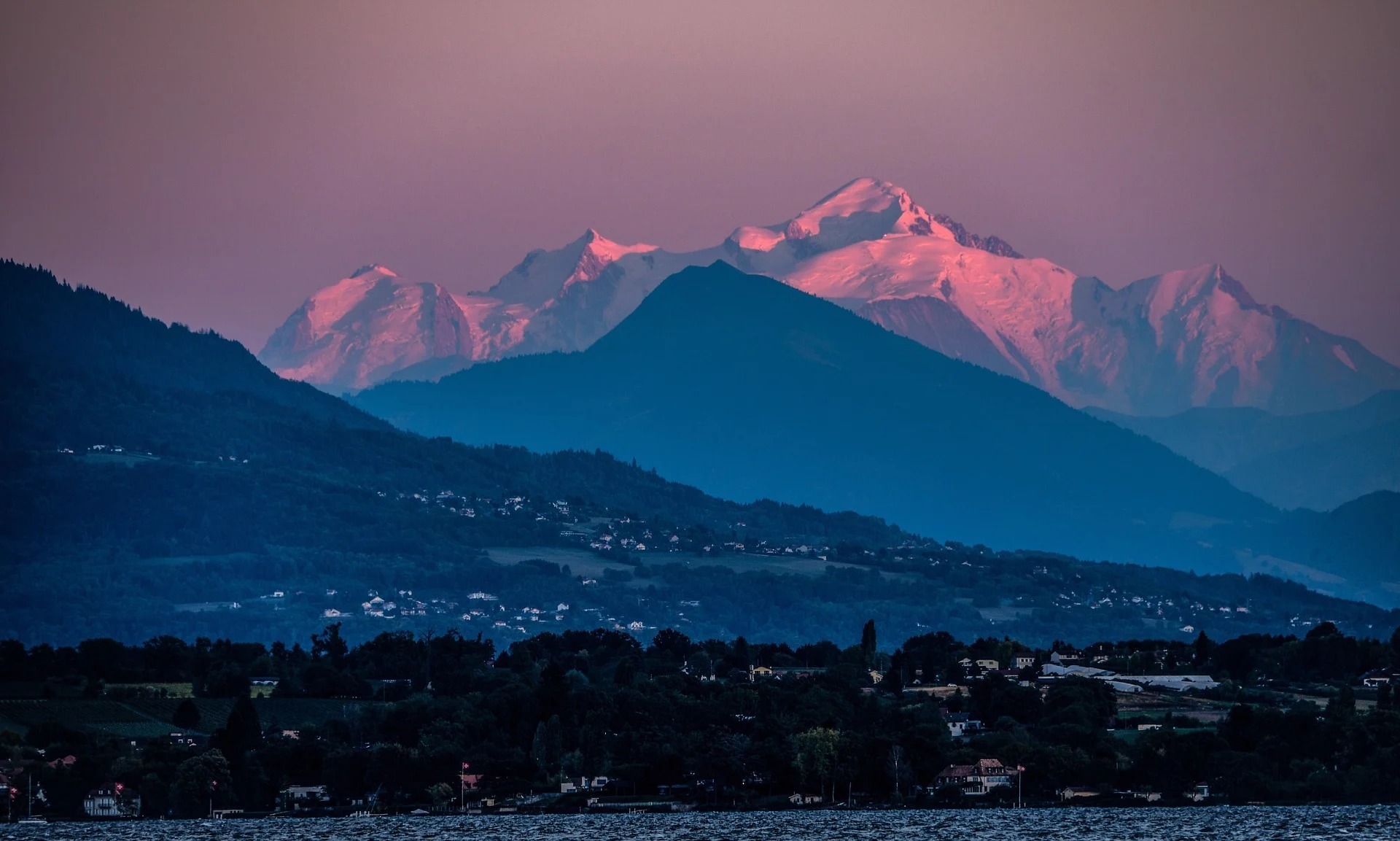
Geneva
Switzerland’s second-most populous city, Geneva is a place where languages, cultures, and institutions have converged for hundreds of years. Here, diplomacy and sophistication play a central role. Formerly home to the headquarters of the UN, Geneva still hosts the International Red Cross, World Trade Organization, and World Health Organization. Lake Geneva, the largest body of water in Switzerland, dominates the surrounding landscape with its calm waters and brooding presence. By the lakeside, the imposing Jet d’Eau blasts water 140 meters into the air for most of every day. As you stroll through the city’s enchanting old town, you'll find its winding streets dusted with antique shops, ancient architecture, galleries, and world-class restaurants. Centuries of influence from countless cultures have given Geneva a special, complex identity. Travelers here can spend hours sampling food and drink from across the world. Or, simply sit by the water, and sip an Espresso while you soak up Geneva's unique and cosmopolitan vibe.
Read More
Learn About Geneva
Build Geneva Trip
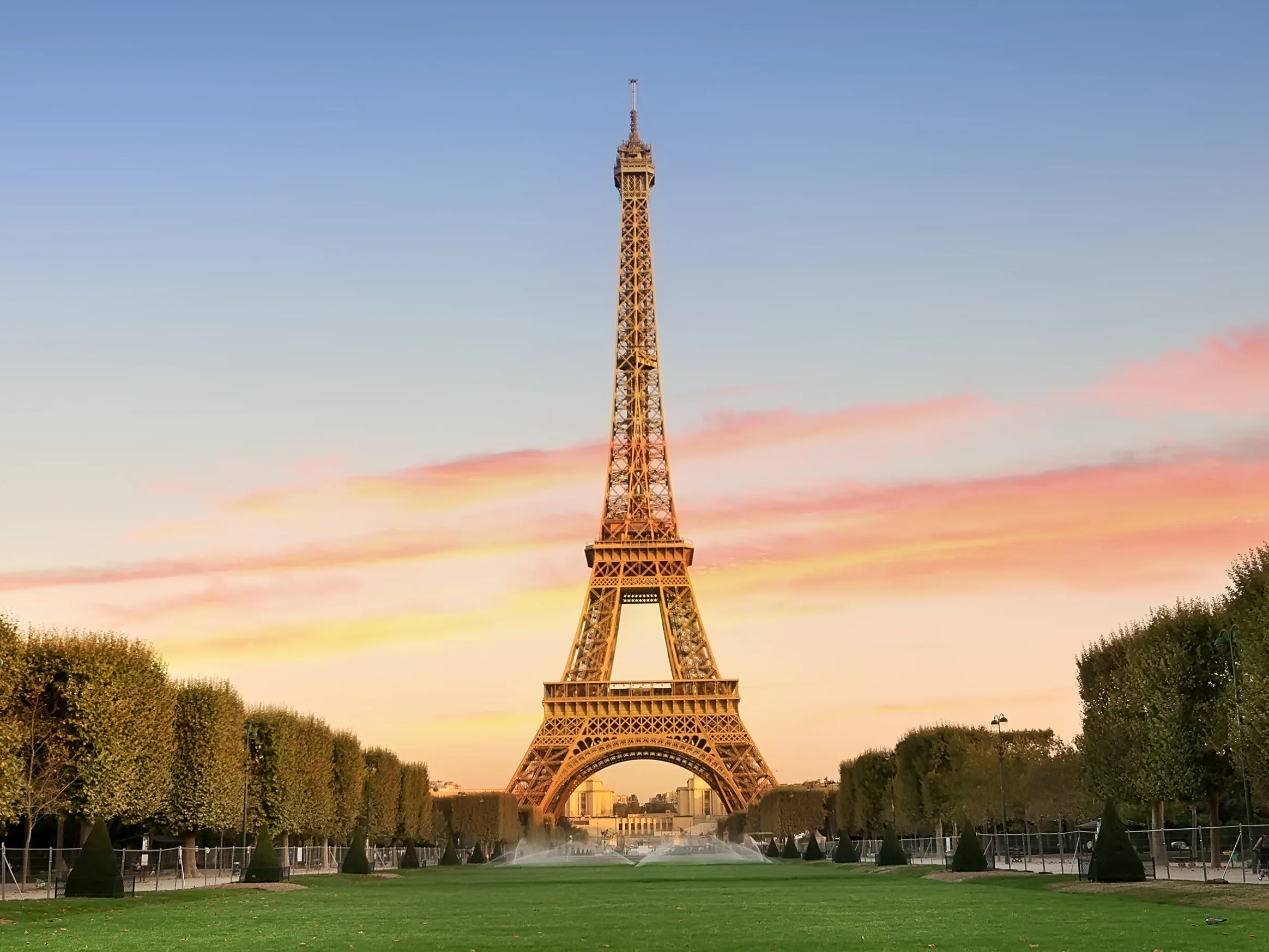
Paris
The magic of Paris is undeniable. This is the most romantic destination in Europe, and surely the number one bucket list destination of all time. If you want to say you've traveled, you have to visit Paris at least once. Along with classic must-sees like the Eiffel Tower and the Sacre-Coeur, there is so much to see and do in Paris that it helps to narrow it down by interest. Fashion and shopping enthusiast? Look no further than the Galeries Lafayette, Avenue des Champs-Élysées, or the Marais. Art aficionado? Once you're done with the Louvre, make a start on the Musée d'Orsay. History buffs won't be able to walk a block without uncovering a monument to Napoleon or Louis XIV. If you visit Paris with a foodie, be warned — you'll gaze in a lot of patisserie windows, and sample your weight in croissants. Because Paris always has so much on offer, it never grows old. At dusk, as you stroll the wide boulevards past Haussmann apartment buildings and sharply dressed Parisians, or gaze down at the city from the hill at Montmarte, you might find yourself saying 'Paris Je t' aime'. This is, after all, the City of Love.
Read More
Learn About Paris
Build Paris Trip

Nuremberg
One of the most authentic, storied German destinations, Nuremberg's picturesque old town, glorious castle, and buzzing Christmas Market makes this city a time-true classic. The ideal gateway to old Bavaria, Nuremberg offers a primer in German history before you embark on the lovely journey through old Bavaria, known as the Romantic Road. Considered the capital of the Holy Roman Empire in the middle ages, Nuremberg would have felt like the center of the world as a procession of kings and emperors passed through its magnificent gates. When the German Renaissance came, Nuremberg was at its heart. Albrecht Dürer, the great German master artist, was born here, and Martin Luther called Nuremberg Germany's 'eyes and ears'. Skip forward a few centuries, and the city took a dark turn, as Nuremberg became a gathering point for the German National Socialists. Slightly outside of town, you can still find the Nazi Party Rallying Grounds, a sobering reminder of the not so distant past. If it all gets too heavy, you can end the day with a glass of rotbier (red beer) and mull it over. Nuremberg is a must-see for anyone who wants to delve into Germany's past.
Read More
Learn About Nuremberg
Build Nuremberg Trip
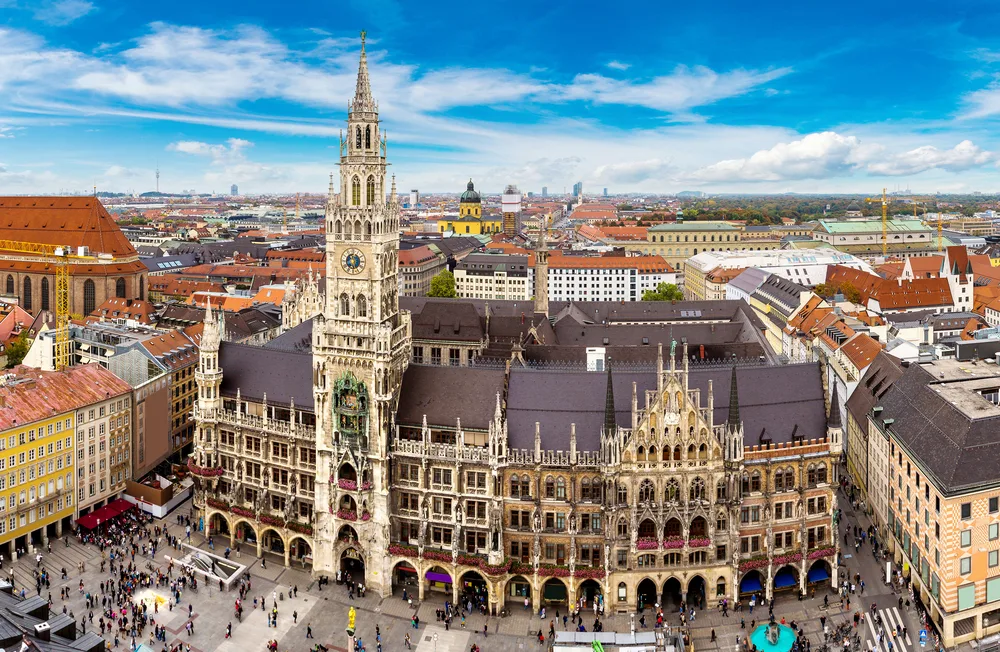
Munich
Arriving in Munich, you would be forgiven for thinking you were on the set of a movie about old Bavaria. At the Old Town beer halls, barmaids laced in dirndl dresses serve up frosty Helles lager, as oom-pah music drifts across the Marienplatz square. Men in lederhosen and checked shirts merrily give toasts as they knock glasses, or steins, as they’re known here. They sit at tables laden with wurst sausage and giant pretzels oozing with herby butter. This is Germany’s Germany, a place where folk traditions never stopped, and the revelry doesn’t either. Even when it isn’t Oktoberfest, the town’s notorious beer-drinking celebration, Munich is always happy to show you a good time. Simply cast your eyes around the lavish, gilded banquet hall at the Munich Residenz, the 13th-century Wittelsbach palace. You’ll see Munich has been impressing guests for centuries. Or, swing by the BMW Museum and check out the classic German cars. They even let you sit inside to test out the new models. At the city’s English Gardens, surfers ride waves on one of the park’s rivers. Munich is filled to the brim with this kind of pure-hearted German fun.
Read More
Learn About Munich
Build Munich Trip
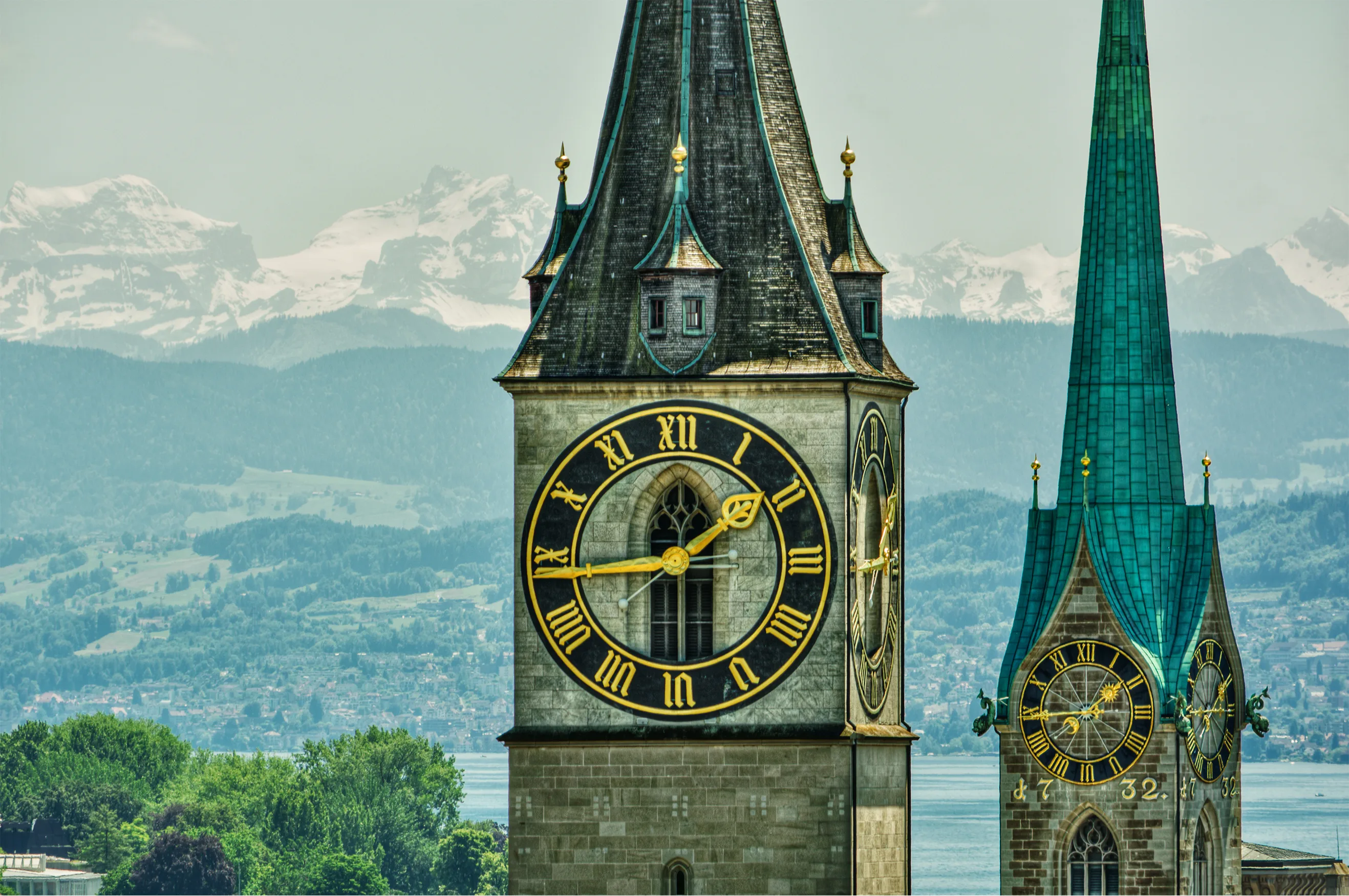
Zurich
Zurich is Switzerland’s biggest city, located in the center of the country’s German-speaking region. It’s this location, superbly connected to almost everywhere else by train and close to an international airport, that makes Zurich an obvious destination for tourists. Well, that’s one of the reasons. There’s also the city’s bevy of bars and restaurants, the lakeside views, and stunning architecture around every corner.Take a stroll down the Bahnhofstrasse, a street known around the world for its unrivaled shopping. Weave through crowds of shoppers as you pass rows of world-famous and exclusive brands. Zurich is a small city, but that just makes it easier to get around. Lindenhof Hill, a slight rise of land in the center, offers views across all of the town. Among the city’s most striking features are the Grossmünster towers, which can also be climbed. This is a proud, sophisticated, and elegant city.
Read More
Learn About Zurich
Build Zurich Trip

Interlaken
Located between two bodies of water — Lake Brienz and Lake Thun — Interlaken is the perfect place to explore the serene natural beauty at Switzerland’s heart. Interlaken is a place for those who seek adventure amid spectacular natural surrounds. Rock climbing, canyoning, bungee jumping, and paragliding are just some of the ways to fill a day here, and countless backpackers descend on the town every summer to do all of these and more. Less intense, but no less rewarding, are the many opportunities for hiking, sailing, and swimming. Or, take to the rails. At the nearby Kleine Scheidegg pass, a train runs through the snowy Swiss Alps to the highest train station on the continent. The fun here doesn’t stop at night. After a hard day of adventure, backpackers flock to the town’s many pubs and bars to soothe their aches and pains with steins of beer. Interlaken is a place where fun and excitement reign supreme and somewhere to experience Switzerland’s striking nature in the most thrilling way.
Read More
Learn About Interlaken
Build Interlaken Trip

Geneva
Switzerland’s second-most populous city, Geneva is a place where languages, cultures, and institutions have converged for hundreds of years. Here, diplomacy and sophistication play a central role. Formerly home to the headquarters of the UN, Geneva still hosts the International Red Cross, World Trade Organization, and World Health Organization. Lake Geneva, the largest body of water in Switzerland, dominates the surrounding landscape with its calm waters and brooding presence. By the lakeside, the imposing Jet d’Eau blasts water 140 meters into the air for most of every day. As you stroll through the city’s enchanting old town, you'll find its winding streets dusted with antique shops, ancient architecture, galleries, and world-class restaurants. Centuries of influence from countless cultures have given Geneva a special, complex identity. Travelers here can spend hours sampling food and drink from across the world. Or, simply sit by the water, and sip an Espresso while you soak up Geneva's unique and cosmopolitan vibe.
Read More
Learn About Geneva
Build Geneva Trip

Paris
The magic of Paris is undeniable. This is the most romantic destination in Europe, and surely the number one bucket list destination of all time. If you want to say you've traveled, you have to visit Paris at least once. Along with classic must-sees like the Eiffel Tower and the Sacre-Coeur, there is so much to see and do in Paris that it helps to narrow it down by interest. Fashion and shopping enthusiast? Look no further than the Galeries Lafayette, Avenue des Champs-Élysées, or the Marais. Art aficionado? Once you're done with the Louvre, make a start on the Musée d'Orsay. History buffs won't be able to walk a block without uncovering a monument to Napoleon or Louis XIV. If you visit Paris with a foodie, be warned — you'll gaze in a lot of patisserie windows, and sample your weight in croissants. Because Paris always has so much on offer, it never grows old. At dusk, as you stroll the wide boulevards past Haussmann apartment buildings and sharply dressed Parisians, or gaze down at the city from the hill at Montmarte, you might find yourself saying 'Paris Je t' aime'. This is, after all, the City of Love.
Read More
Learn About Paris
Build Paris Trip

Nuremberg
One of the most authentic, storied German destinations, Nuremberg's picturesque old town, glorious castle, and buzzing Christmas Market makes this city a time-true classic. The ideal gateway to old Bavaria, Nuremberg offers a primer in German history before you embark on the lovely journey through old Bavaria, known as the Romantic Road. Considered the capital of the Holy Roman Empire in the middle ages, Nuremberg would have felt like the center of the world as a procession of kings and emperors passed through its magnificent gates. When the German Renaissance came, Nuremberg was at its heart. Albrecht Dürer, the great German master artist, was born here, and Martin Luther called Nuremberg Germany's 'eyes and ears'. Skip forward a few centuries, and the city took a dark turn, as Nuremberg became a gathering point for the German National Socialists. Slightly outside of town, you can still find the Nazi Party Rallying Grounds, a sobering reminder of the not so distant past. If it all gets too heavy, you can end the day with a glass of rotbier (red beer) and mull it over. Nuremberg is a must-see for anyone who wants to delve into Germany's past.
Read More
Learn About Nuremberg
Build Nuremberg Trip

Munich
Arriving in Munich, you would be forgiven for thinking you were on the set of a movie about old Bavaria. At the Old Town beer halls, barmaids laced in dirndl dresses serve up frosty Helles lager, as oom-pah music drifts across the Marienplatz square. Men in lederhosen and checked shirts merrily give toasts as they knock glasses, or steins, as they’re known here. They sit at tables laden with wurst sausage and giant pretzels oozing with herby butter. This is Germany’s Germany, a place where folk traditions never stopped, and the revelry doesn’t either. Even when it isn’t Oktoberfest, the town’s notorious beer-drinking celebration, Munich is always happy to show you a good time. Simply cast your eyes around the lavish, gilded banquet hall at the Munich Residenz, the 13th-century Wittelsbach palace. You’ll see Munich has been impressing guests for centuries. Or, swing by the BMW Museum and check out the classic German cars. They even let you sit inside to test out the new models. At the city’s English Gardens, surfers ride waves on one of the park’s rivers. Munich is filled to the brim with this kind of pure-hearted German fun.
Read More
Learn About Munich
Build Munich Trip

Zurich
Zurich is Switzerland’s biggest city, located in the center of the country’s German-speaking region. It’s this location, superbly connected to almost everywhere else by train and close to an international airport, that makes Zurich an obvious destination for tourists. Well, that’s one of the reasons. There’s also the city’s bevy of bars and restaurants, the lakeside views, and stunning architecture around every corner.Take a stroll down the Bahnhofstrasse, a street known around the world for its unrivaled shopping. Weave through crowds of shoppers as you pass rows of world-famous and exclusive brands. Zurich is a small city, but that just makes it easier to get around. Lindenhof Hill, a slight rise of land in the center, offers views across all of the town. Among the city’s most striking features are the Grossmünster towers, which can also be climbed. This is a proud, sophisticated, and elegant city.
Read More
Learn About Zurich
Build Zurich Trip

Interlaken
Located between two bodies of water — Lake Brienz and Lake Thun — Interlaken is the perfect place to explore the serene natural beauty at Switzerland’s heart. Interlaken is a place for those who seek adventure amid spectacular natural surrounds. Rock climbing, canyoning, bungee jumping, and paragliding are just some of the ways to fill a day here, and countless backpackers descend on the town every summer to do all of these and more. Less intense, but no less rewarding, are the many opportunities for hiking, sailing, and swimming. Or, take to the rails. At the nearby Kleine Scheidegg pass, a train runs through the snowy Swiss Alps to the highest train station on the continent. The fun here doesn’t stop at night. After a hard day of adventure, backpackers flock to the town’s many pubs and bars to soothe their aches and pains with steins of beer. Interlaken is a place where fun and excitement reign supreme and somewhere to experience Switzerland’s striking nature in the most thrilling way.
Read More
Learn About Interlaken
Build Interlaken Trip
prev
next


 Map of Your Itinerary Route
Map of Your Itinerary Route
Zoom In to the cities to see your itinerary in more detail


 4.8
4.8 







